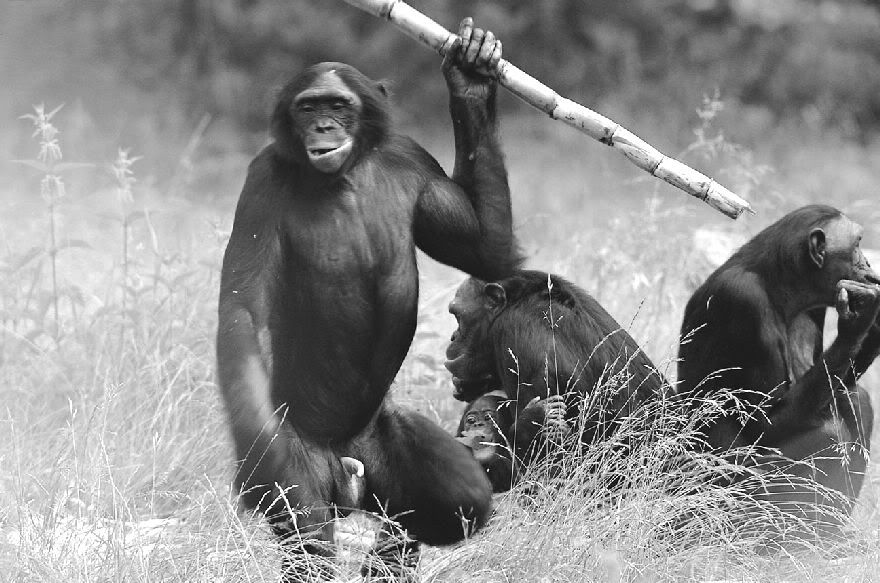Our primate cousins could turn the question of human origins upside down.

Could the bonobo homeland also be the origin of our common ancestor?
Image: Cyril Ruoso / Time
“I really strongly feel that people may have evolved from this region,” he said. "It’s a big claim, yes, I understand, but I really think it is worth it to put it on the table."
The vast majority of hominin fossils have been found in eastern Africa, in what is modern day Ethiopia, Kenya and Tanzania. The most reasonable assumption has long been that it was in East Africa, near the Rift Valley, where the Pan-Homo division took place. However, the earliest hominin fossil find to date, Sahelanthropus tchadensis, is between 6-7 mya and was found in in the central African country of Chad (about 2,500 km away). S. tchadensis was much more ape-like than later Australopithecines and is thought to have coexisted alongside our common ancestor with chimpanzees and bonobos.
This early Chad find is important considering that the fossil record is so sparse between 12 mya and 4 mya (the crucial period as far as we're concerned). The only representatives of this vast period after S. tchadensis was Orrorin tugenensis (6 mya from Kenya) an ape species that may have been partially bipedal, Ardipithecus ramidus kadabba (5.5 mya from Ethiopia) and Ardipithecus ramidus ramidus (4.4 mya also from Ethiopia). All of these species were much more apelike than the Australopithecines, which first appear in the fossil record 4.15 mya in Kenya and 4.1 mya in Ethiopia. An excellent timeline at hominin.net helps put these dates and the location of the finds into context.

Fossil map showing many of the hominin fossil discoveries throughout Africa.
Image: National Geographic
While Ethiopia or Kenya would seem to be the most likely candidates for the split between Homo and Pan, the fact that the earliest known hominin has been found in Chad has raised some questions about this. Writing in the journal Nature about how the discovery of S. tchadensis changes our understanding of early human origins, Brunet. et al state:
This suggests that an exclusively East African origin of the hominid clade is unlikely to be correct. It will never be possible to know precisely where or when the first hominid species originated, but we do know that hominids had dispersed throughout the Sahel and East Africa by 6 Myr.Furthermore, Australopithecus bahrelghazali (about 3.6 mya) was also discovered in Chad, suggesting that there is a great deal of material still to be discovered in this region. Later hominin fossils have also been discovered in South Africa (such as Australopithecus africanus and Paranthropus robustus). This means that the distribution of hominins extends all the way from Chad to East Africa to South Africa. Interestingly, the nearest central point between all these locations is the Democratic Republic of Congo.
"The bonobo may more closely resemble the common ancestor of all three modern species," De Waal says. "It's an important issue that's yet to be resolved."

Bonobos are the only primate, other than humans, that regularly walk upright.
Image: Unattributed
Unfortunately, fossils are unlikely to help. Rain forest soils are notoriously bad for fossilization. The bones will decay long before minerals can replace the organic material. Even in ideal conditions (such as arid or anoxic environments) fossilization is extremely rare. So there is a certain amount of "environmental bias" in the fossil record. Unless an organism had a large enough range to be living in the right location for fossilization to occur, there will be no record that they ever existed. This could mean that the hominin fossils we do have were from individuals after they had migrated to the far edge of their original range and that the really exciting evolutionary events occurred in Central Africa. If this is the case, then the reason we have so many fossils from East Africa isn't because that was the cradle of humanity, it's just because the conditions were right for fossilization. Unfortunately, without evidence to test this hypothesis it remains in the realm of mere conjecture.
One piece of evidence that makes me think bonobos and humans might have shared more than just a similar environment has to do with a region of DNA promoting the release of oxytocin. At the AVPR1A gene both humans and bonobos (but not chimpanzees) share a repetitive microsatellite locus that Elizabeth Hammock and Larry Young have shown to be important for cooperation, empathy and social bonding. It is far more parsimonious that chimpanzees lost this repetitive microsatellite than for both humans and bonobos to independently develop the same mutation.
So if I had to make my best guess, I would put my money on the Pan-Homo split occuring in the mosaic environments of Central Africa near DR Congo. I would also predict that this common ancestor would appear more bonobo-like than chimpanzee-like. We may never know the real answer. But, considering the exciting "hobbit" fossils discovered on the island of Flores, Indonesia, it may be possible for fossilization to occur even in the rain forest if conditions are just right. At this moment, somewhere in a cave near Lac Tumba in the Democratic Republic of Congo, our common ancestor with bonobos and chimpanzees may be lying in wait for the next intrepid explorer to unearth. If so it would be the anthropological find of the century. Our long search to understand human origins would finally be at an end.


















5 comments:
Thanks for the info on the AVPR1A gene, I hadn't yet heard that.
And, I agree - central Africa may yield as yet undiscovered fossils. But who is actually going to be able to get digs going there? The conditions — politically, socially, historically, financially, etc — are terrible compared with eastern Africa.
It's a difficult situation, no doubt about it. However, the majority of the violence is taking place in eastern DR Congo near the border with Rwanda. Frances White and Jef Dupain are still able to work at their field sites (so far as I know) in Lomako which is in central DRC. Brian Hare continues to work at Lola ya Bonobo in Western DRC and the Lac Tumba reserve where Bila-Isia Inogwabini works is also in the West. Additional pressure needs to be put on the international community to pay attention to the crisis in Congo. It's the only chance the Congolese people and the endangered bonobo have.
Since the earliest African hominin, Sahelanthropus, is dated between 6.8 to 7.2 MYA, how could the human chimp split have occurred less than 6.2 million years ago?
http://newpapyrusmagazine.blogspot.com/1999/01/our-earliest-african-ancestor.html
Thanks for the question Marcel. Sahelanthropus could be the ancestor of both Pan and Homo, which would mean the Pan-Homo split occurred later, or maybe they were a side branch and were actually the ancestors of modern day gorillas. However, if it could be conclusively shown that Sahelanthropus tchadensis has more features in common with early hominins than with extant chimpanzees and bonobos it would suggest that the Pan-Homo split occurred at the tail end of the time range suggested by the genetic evidence (or about 6 million years ago). To my mind, it's still too early to know if S. tchadensis was a direct ancestor of hominins. Additional fossil material from this time period is needed in order to have a better understanding of the range of features in this species. Since this is the only fossil from this time period it's a very important one, but the full picture will only emerge once many more fossils are discovered to provide additional details. They're out there and it's only a matter of time before they're unearthed.
For more info see:
Wolpoff et al. (2002)
Sahelanthropus Intro at John Hawks Weblog.
The chimpanzee and gorilla each share only 5 cranio-dental similarities with Sahelanthropus while amongst the hominins (Homo and Australopithecus), Homo has 10 cranio-dental similarities with Sahelanthropus, Australopithecus has 14 cranio-dental similarities Sahelanthropus.
So I think its already pretty conclusive that Sahelanthropus was a hominin and not an ape.
Post a Comment